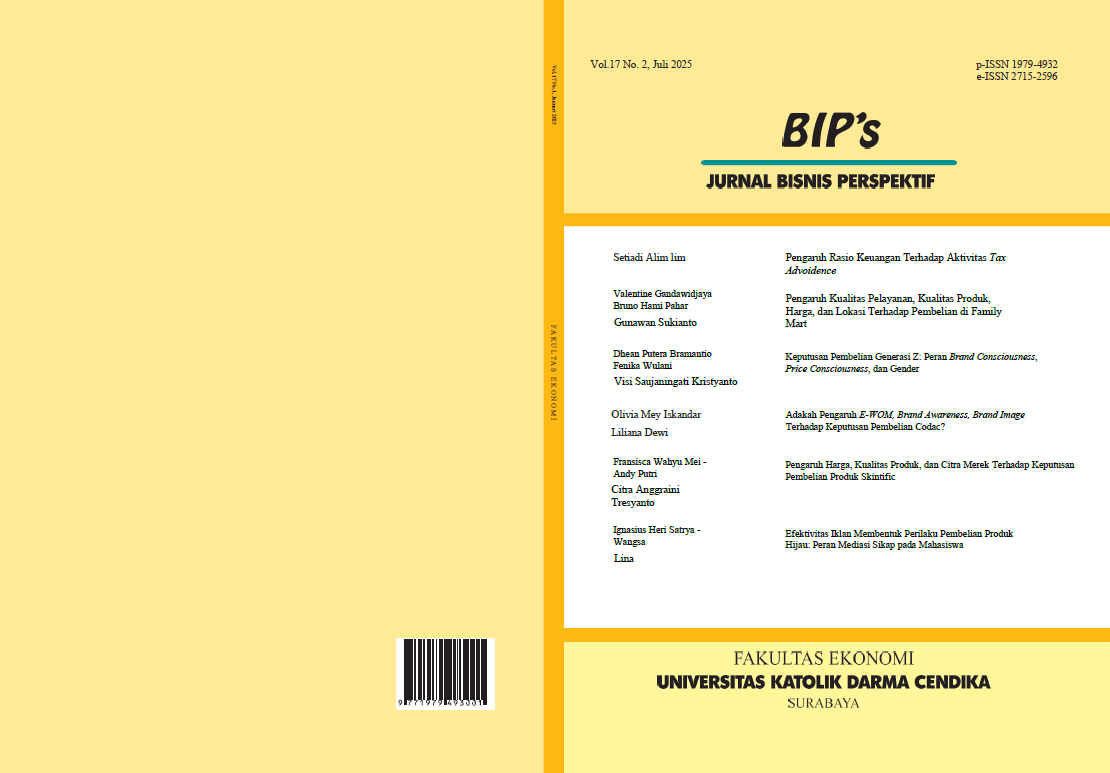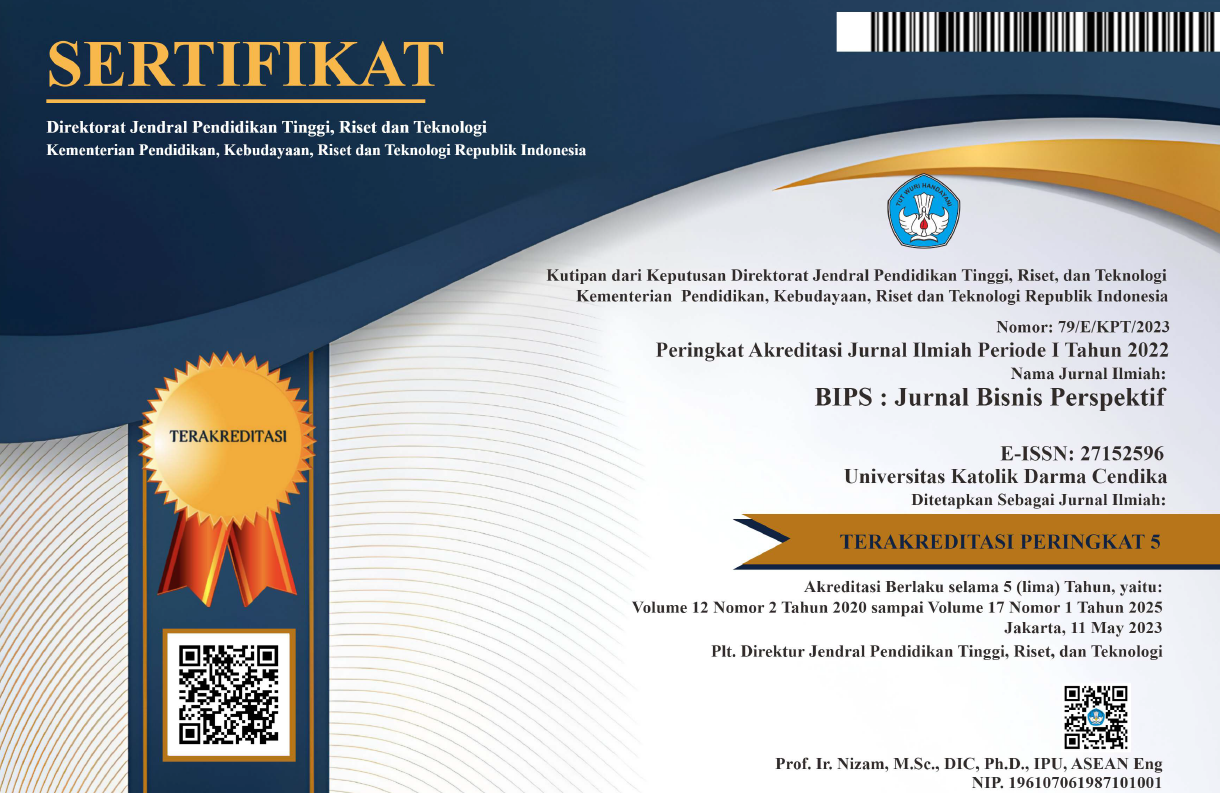Pengaruh Rasio Keuangan Terhadap Aktivitas Tax Avoidance
DOI:
https://doi.org/10.37477/bip.v17i2.764Keywords:
financial ratio, tax avoidance, tax evasionAbstract
Taxes are deducted from net income and are classified as costs for the company. There is a tendency for companies to reduce the amount of tax paid to maximize the amount of profit. Efforts to reduce the amount of tax paid, some violate tax provisions and regulations (tax evasion), and some do not violate tax provisions and regulations (tax avoidance). Tax avoidance is one of the important issues that is widely studied. This study examines tax avoidance and is intended to obtain evidence of whether there is an effect of financial ratios on tax avoidance. There are five financial ratios used in this study, namely return on assets, leverage, company size, property, plant and equipment, and cash flow from operations which are used as independent variables. While the dependent variable is tax avoidance. The research conducted is classified as quantitative research and is intended to test the developed hypothesis. The population of the study is all companies on the Indonesia Stock Exchange (IDX) engaged in the pharmaceutical business. Sampling using the non-probability purposive sampling method and 10 sample companies were obtained. The data used are company financial report data from 2013-2023. Data analysis using multiple linear regression. The results of the study indicate that simultaneously (F test) all independent variables have an effect on the dependent variable. However, when a partial analysis (t test) is carried out, of the five independent variables used, only one independent variable has an effect on the dependent variable. The financial ratios that have an effect on tax avoidance are property, plant and equipment, while the other four financial ratios, namely return on assets, leverage, company size, and cash flow from operations, do not have an effect on tax avoidance. The results of this study differ from several previous studies. Several previous studies showed that the five independent variables partially had an effect on the dependent variable. The difference in the results of this study may be because the companies studied were not heterogeneous in their business fields, only limited to companies with pharmaceutical business fields.
References
Carbonara, E., Curry, P. A., Hill, C. A., & Parisi, F. (2024). Institutional Flexibility in Tax Law and Enforcement. International Review of Law and Economics, 79, 1–11. https://doi.org/10.1016/j.irle.2024.106215
Graham, J. R., & Tucker, A. L. (2005). Tax Shelters and Corporate Debt Policy.
Guias, E. G., & Haineala, C. M. (2021). Tax Avoidance and Tax Evasion in EU: Trend and Effects. The Annals of The University of Oradea. Economic Sciences, 30(2), 229–238. https://doi.org/10.47535/1991auoes30(2)024
Gujarati, D. N., & Porter, D. C. (2009). Basic Econometrics (Fifth Edit). McGraw-Hill/Irwin.
Jaafar, S. B., Salleh, A., & Hamzah, H. (2021). Financial Ratio Analysis as a Device for Predicting Financial Distress. SSRN Electronic Journal. https://doi.org/10.2139/ssrn.3818116
Khurana, I. K., & Moser, W. J. (2011). Shareholder Investment Horizons and Tax Aggressiveness. SSRN Electronic Journal. https://doi.org/10.2139/ssrn.1517913
Kim, J., & Im, C. (2017). Study on Corporate Social Responsibility (CSR): Focus on Tax Avoidance and Financial Ratio Analysis. Sustainability (Switzerland), 9(10), 1–15. https://doi.org/10.3390/su9101710
Manzon, G. B., & Plesko, G. A. (2002). The Relation Between Financial and Tax Reporting Measure of Income. Tax Law Review, 55, 175–214.
Mkadmi, J. E., & Ali, W. Ben. (2024). How Does Tax Avoidance Affect Corporate Social Responsibility and Financial Ratio in Emerging Economies? Journal of Economic Criminology, 5, 1–8. https://doi.org/10.1016/j.jeconc.2024.100070
Moazzem, K. G., Habib, S. M. A., & Fariha, C. (2023). Corporate Tax Transparency: Issues and Concerns in Bangladesh. Centre for Policy Dialogues (CPD), Dhaka. https://doi.org/10.1007/978-3-031-22097-5_7
Mourre, G., & Reut, A. (2017). Non-Tax Revenue in The European Union: A Source of Fiscal Risk? (Vol. 8022, Issue February). https://doi.org/10.2765/63789
OECD. (2020). Revenue Statistics in Asian and Pacific Economies 1990-2018. OECD Publishing, Paris. https://doi.org/https://doi.org/10.1787/d47d0ae3-en.
Oladipupo, O. F., & Oladipo, O. N. (2022). The Combine Impact of Tax and Non-Tax Revenue in Stimulating Economic Growth, Mediating on the Role of Public Sector Financial Management. Italienisch, 12(1), 448–456.
Prichard, W., Salardi, P., & Segal, P. (2018). Taxation, Non-Tax Revenue and Democracy: New Evidence Using New Cross-Country Data. World Development, 109, 295–312. https://doi.org/10.1016/j.worlddev.2018.05.014
Rahman, M. J., & Ll, L. (2021). Corporate Social Responsibility (CSR): Focus on Tax Avoidance and Financial Ratio Analysis. Accontantcy Business and Public Interest, 73–89.
Stiglingh, M., Smit, A.-R., & Smit, A. (2020). The Relationship Between Tax Transparency and Tax Avoidance. South African Journal of Accounting Research, 1–21. https://doi.org/10.1080/10291954.2020.1738072
Suthar, K. U. (2018). Financial Ratio Analysis: A Theoretical Study. International Journal of Research in All Subjects in Multi Languages, 6(3), 61–64. https://www.researchgate.net/publication/376043402
Tanchev, S. (2016). The Role of The Proportional Income Tax on Economic Growth of Bulgaria. Economic Studies Journal, XXV(4), 66–77.
Yurdadoğ, V., Karadağ, N. C., Albayrak, M., & Bozatlı, O. (2022). Analysis of Non-Tax Revenue: Evidence From European Union. Amfiteatru Economic, 24(60), 485–506. https://doi.org/10.24818/EA/2022/60/485
Downloads
Published
How to Cite
Issue
Section
License
Copyright (c) 2025 Setiadi Alim Lim

This work is licensed under a Creative Commons Attribution-NonCommercial-ShareAlike 4.0 International License.
Authors publishing in this journal agree to the following terms:
- The author retains copyright and grants the journal rights of first publication with the work simultaneously licensed under a Creative Commons Attribution ShareAlike License License that allows others to share the work with acknowledgment of the author's work and initial publication in BIP's: Journal of Business Perspectives.
- Authors may include separate additional contractual arrangements for non-exclusive distribution of the published version of the journal (e.g., submit to an institutional repository or publish in a book), with an acknowledgment of the original publication in this Journal.
- Authors are permitted and encouraged to post their work online (e.g., in institutional repositories or on their websites) before and during the submission process, as it can lead to productive exchanges, as well as citations of previously published work.
Each author is expected to complete the copyright process with a document of the originality of the manuscript, the templated document is below:


7.png)


6.png)
2.png)


